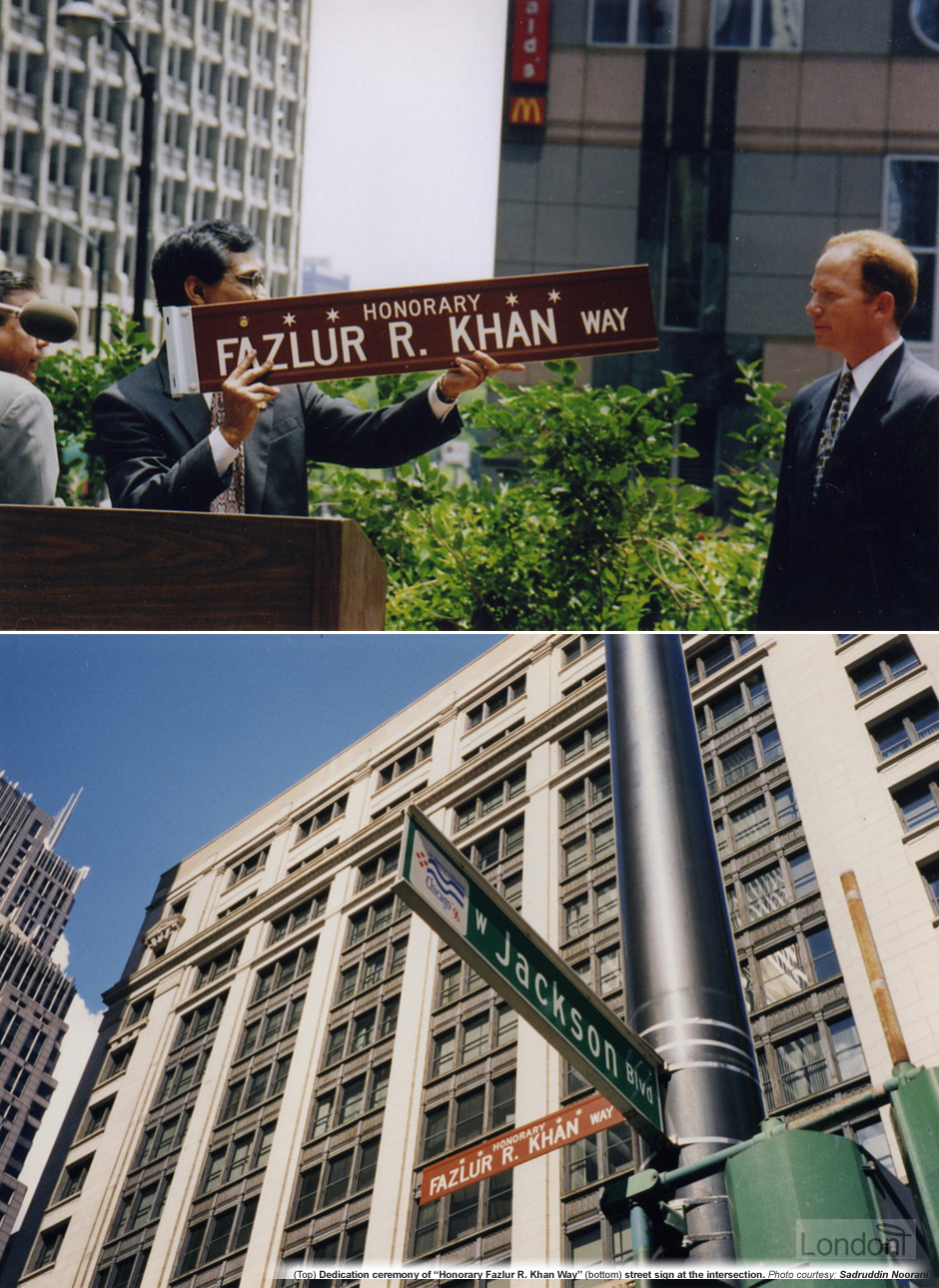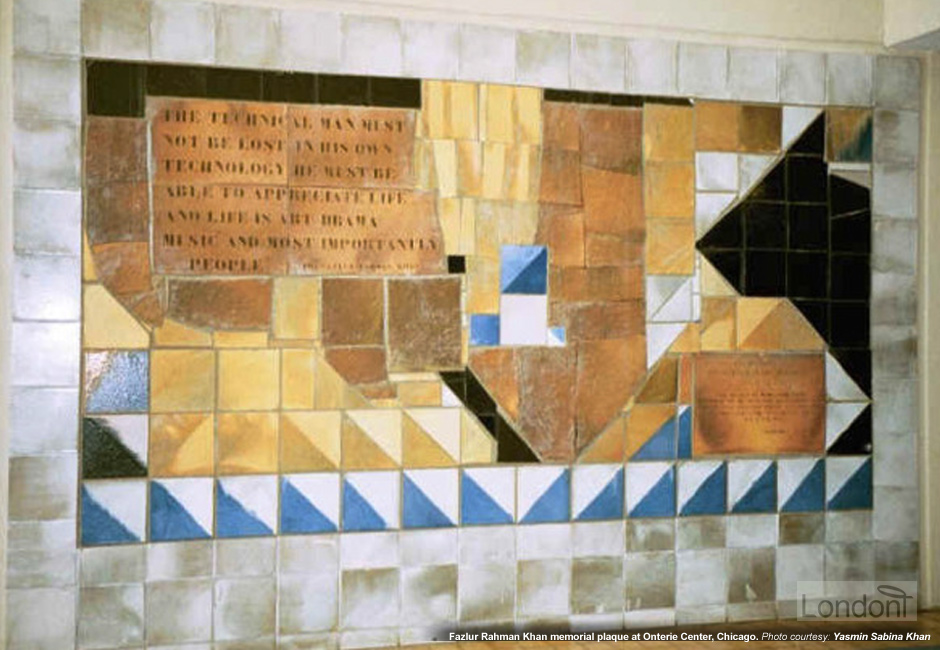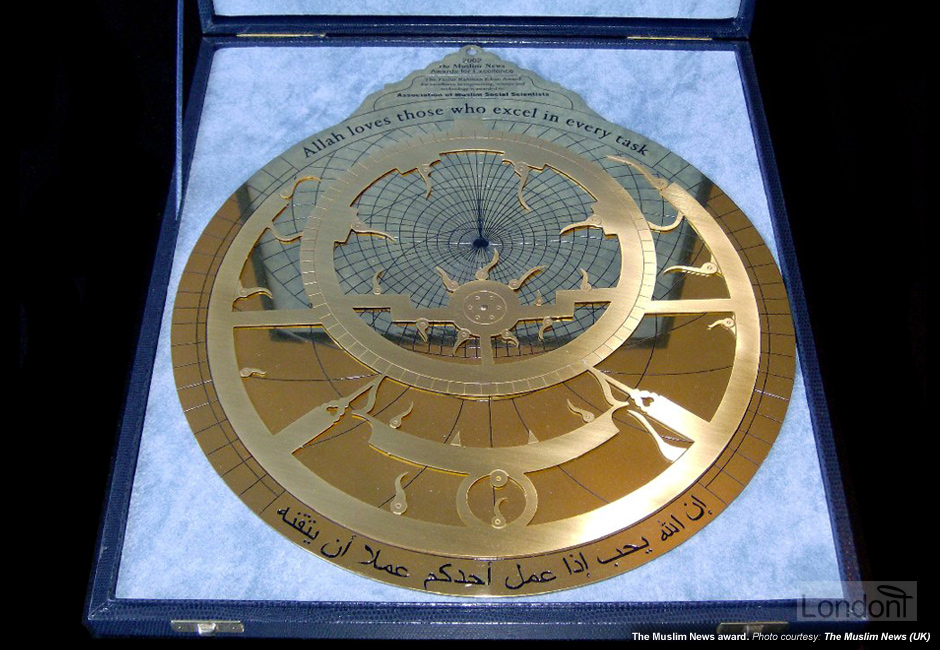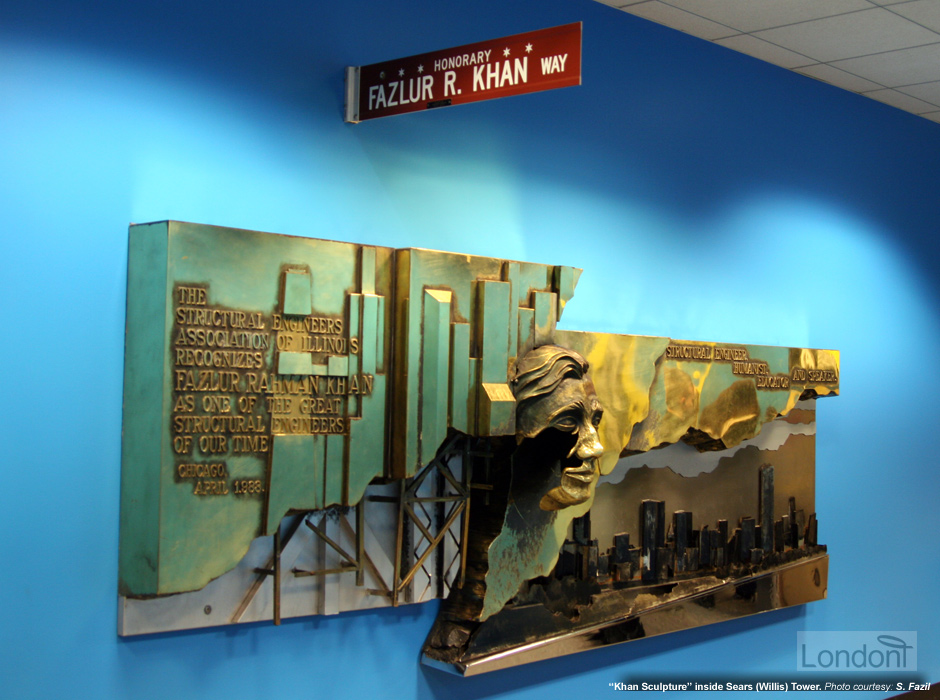
"Fazlur R. Khan Way"
Last updated: 10 October 2017 From the section Fazlur Rahman (F. R.) Khan
Posthumously, in 1998 the city of Chicago named the intersection of West Jackson Boulevard and South Franklin Street, located at the foot of the Sears Tower, "Fazlur R. Khan Way" in honour of their high regard for Fazlur Khan's accomplishments as an engineer.
One year later, in 1999, Engineering News-Record listed him as one of the world's top 20 structural engineers of the last 125 years. He was named as one of its top 125 people of the last 125 years, a list that included such luminaries as inventor Thomas Edison, architect Frank Lloyd Wright and structural engineer Gustave Eiffel.
Khan combined technical genius with a sensitivity for people and where they work.
Three decades earlier, in 1970 when Fazlur Khan was 41 years old, the Chicago Junior Chamber of Commerce had named him Chicagoan of the Year in Architecture and Engineering.
A replica of the "Fazlur R. Khan Way" street sign is also displayed above the "Khan Sculpture" within Sears (Willis) Tower.

Memorial plaque in Onterie Center, Chicago
A large mosaic memorial plaque of Fazlur Rahman Khan can be found on the east wall of the office lobby of the Onterie Center in Chicago. The mosaic was added by Chandra K. Jha, former President of India League of America and original owner and developer of the Onterie Center, and designed by French-born artist Juan Gardy-Artigas from Barcelona, Spain.
The tile wall mural adorning the oak-paneled lobby includes two text sections. On one section it features Fazlur Khan's famous statement which he made to an editor after being voted 'Construction's Man of the Year' by Engineering News-Record in 1972:
The technical man must not be lost in his own technology. He must be able to appreciate life; and life is art, drama, music, and most importantly, people.
The other text section dedicates the building to the memory of Fazlur Khan:
In Memoriam
Dr. Fazlur Rahman Khan (4-3-29 – 3-27-82)
World-renowned structural engineer, whose lasting contributions to architecture illuminated all our paths. We dedicate this plaque with gratitude to Dr. Khan for his leadership in engineering practice which culminated in this structure, Onterie Center - his final work.
The lobby containing the plaque has became a kind of shrine for structural engineers.
Many structural engineers from around the world have come to Chicago and visited the building and viewed the memorial wall and mosaic plaque.
Deborah Zroka, President of the Structural Engineers Association of Illinois

"Fazlur Khan Award for Excellence in Engineering, Science & Technology" by The Muslim News Awards
In 2000 The Muslim News, the largest independent Muslim newspaper in Britain, launched the 'The Muslim News Awards for Excellence' to recognise achievement and promote excellence within the UK Muslim community.
The newspaper, first published in 1989, receives a large readership from mainly second and third generation Muslims whose ethnicity range from Bengali to Turkish to Afro-Caribbean. It's the oldest and most well established Muslim newspaper in UK and is the most consulted paper in UK, both by Muslims and Non-Muslims, on domestic and international issues relating to Muslims.
The Award is a prestigious event held every year (except in 2003 and 2007) and is well attended by top dignitaries, both Muslims and Non-Muslims, from various profession.
It [i.e. The Muslim News Awards for Excellence] highlights the achievements in the Muslim community. It is also intended that by identifying Muslim achievers and success stories around the UK, we will go some way towards providing the much needed positive role models for our younger generation, and towards countering the misconceptions and prejudice that, more often than not, surround Muslim community representation in the media.
There are numerous award categories and all but one are named after Muslims individual or organisation who have excelled in that profession. Amongst these categories is the 'Fazlur Rahman Khan award for excellence in engineering / science / technology' which is given to people or organisation who have achieved excellence in those field. Other category includes 'Ibn Sina award for health', 'Ibn Khaldun award for excellence in promoting understanding between global cultures and faiths', and 'Malcolm X young person's award for excellence' which is given to an individual, organisation or initiative run by young people (16-25 years), whose principal aim is to support and create opportunities for their peers. The only category to be named after a non-Muslim is the 'Annemarie Schimmel award for championing a Muslim cause' which is given to a non-Muslim individual, initiative or organisation which/who has supported a Muslim cause.
Award categories are:
- Al Biruni award for excellence in community relations = For promoting understanding and respect between Muslim and non-Muslim communities at the national or local level.
- Ibn Sina award for health = This award recognises those who excel and promote in health issues.
- Al-hambra award for excellence in arts = For achievement to fine art, the performing art or architecture.
- Ibn Battuta award for excellence in media = For fair, accurate and balanced reporting on an issue involving Muslims nationally or internationally.
- Uthman Dan Fodio award for excellence in community development = For a person, project, or initiative aimed at raising the quality of life of Muslims locally or nationally.
- Malcolm X young person’s award for excellence = To be given to an individual, organisation or initiative run by young people (16-25 years), whose principal aim is to support and create opportunities for their peers.
- Alija Izetbegovic award for good citizenship = For showing courage and determination in securing rights for British Muslims.
- Ummul Mu’minin Khadijah award for excellence in enterprise = For achievement in business and commerce.
- Annemarie Schimmel award for championing a Muslim cause = For a non-Muslim individual, initiative or organisation which /who has supported a Muslim cause.
- Allama Iqbal award for creativity in Islamic thought = For the development of a new, innovative and challenging approach to the understanding and application of Islam.
- Faezeh Hashemi award for excellence in sports = For outstanding sporting achievement or the initiation of a sports project for the benefit of the Muslim community at national or local level.
- Fazlur Rahman Khan award for excellence in engineering / science / technology.
- Sankore University award for excellence in education.
- Ibn Khaldun award for excellence in promoting understanding between global cultures and faiths = For a person or organisation who has demonstrated outstanding achievement in, or commitment to, promoting international understanding between cultures and/or faiths.
- Imams Hasan and Husayn children’s award for excellence = This award is for a child (5 to 15 years) who has demonstrated outstanding achievement.
- Iman wa Amal special award = For outstanding contribution to Islam and Muslims. a special award at the discretion of the judges.
Winners
The first winner of the "Fazlur Khan Award for Excellence in Engineering, Science & Technology" was Professor M. Y. H. Bangash, a professor of nuclear/aerospace structures from Pakistan, in 2000.
 2000: M. Y. H Bangash () Professor of nuclear/aerospace structures. Published over 75 research papers and 24 books. Designer of nuclear power. Worked at the UK Atomic Energy Commission as a Consulting Engineer. Originally from northern Pakistan. Won Full Bright Scholarship to USA in 1960 and studied at the Massachusetts Institute of Technology. Active in voluntary work - he has been President of the Council of Muslim Education at the Islamic Cultural Centre at Regent's Park in London and has also been active with the Union of Muslim Organisations.
2000: M. Y. H Bangash () Professor of nuclear/aerospace structures. Published over 75 research papers and 24 books. Designer of nuclear power. Worked at the UK Atomic Energy Commission as a Consulting Engineer. Originally from northern Pakistan. Won Full Bright Scholarship to USA in 1960 and studied at the Massachusetts Institute of Technology. Active in voluntary work - he has been President of the Council of Muslim Education at the Islamic Cultural Centre at Regent's Park in London and has also been active with the Union of Muslim Organisations.  2001: Monzur Ahmed (Technology) & Salim Al-Hassani (Science and engineering) () Monzur Ahmed is a consultant gastroenterologist at a busy city hospital in Birmingham. He has researched extensively on the phases of the moon and devised free computer programs and Internet webpages that calculate prayer times, the beginning of lunar months, and the direction of Makkah. Salim Al-Hassani is Professor of Mechanical Engineering at the University of Manchester Institute of Science and Technology. He is well known in the field of impact engineering and publishes and lectures all over the world. He is also actively involved in Manchester’s Muslim community, and helped to set up Manchester Central Mosque, the Muslim Youth Foundation and student Islamic societies at UMIST and Manchester University.
2001: Monzur Ahmed (Technology) & Salim Al-Hassani (Science and engineering) () Monzur Ahmed is a consultant gastroenterologist at a busy city hospital in Birmingham. He has researched extensively on the phases of the moon and devised free computer programs and Internet webpages that calculate prayer times, the beginning of lunar months, and the direction of Makkah. Salim Al-Hassani is Professor of Mechanical Engineering at the University of Manchester Institute of Science and Technology. He is well known in the field of impact engineering and publishes and lectures all over the world. He is also actively involved in Manchester’s Muslim community, and helped to set up Manchester Central Mosque, the Muslim Youth Foundation and student Islamic societies at UMIST and Manchester University.  2002: Association of Muslim Social Scientists () Provide a unique platform for the development of Islamic thought through research, scholarship and publications. Since its inception in 1996, it has created an awareness of Islamic alternatives and opinions on topical and emerging academic issues relevant to Muslims. The association hosts successful conferences in the UK and Europe, drawing on the contribution of analysts and researchers throughout the Muslim community.
2002: Association of Muslim Social Scientists () Provide a unique platform for the development of Islamic thought through research, scholarship and publications. Since its inception in 1996, it has created an awareness of Islamic alternatives and opinions on topical and emerging academic issues relevant to Muslims. The association hosts successful conferences in the UK and Europe, drawing on the contribution of analysts and researchers throughout the Muslim community.  2004: Fazlun Khalid () After a long career with the Commission for Racial Equality, Fazlun Khalid forged a second as a foremost expert on ecology from the Islamic perspective. He has established the NGO, the Islamic Foundation for Ecology and Environmental Science, and is a consultant to the World Wide Fund for Nature and a Director of training at the Alliance of Religions and Conservation. Fazlun has written Qu'ran, Creation and Conservation and has edited Islam and Ecology. He lives in Granada, Spain.
2004: Fazlun Khalid () After a long career with the Commission for Racial Equality, Fazlun Khalid forged a second as a foremost expert on ecology from the Islamic perspective. He has established the NGO, the Islamic Foundation for Ecology and Environmental Science, and is a consultant to the World Wide Fund for Nature and a Director of training at the Alliance of Religions and Conservation. Fazlun has written Qu'ran, Creation and Conservation and has edited Islam and Ecology. He lives in Granada, Spain. 2005: Prof. Tariq Salim Durrani () Deputy Principal and Professor of Signal Processing at the University of Strathclyde. He is Director of the Institute for System Level Integration and the Scottish Electronics Technology Group. He is responsible for lifelong learning, staff development and the promotion of entrepreneurship as well as university and industry collaborative research. He is also a Fellow of the Royal Academy of Engineering, the IEE and the Royal Society of Edinburgh.
2005: Prof. Tariq Salim Durrani () Deputy Principal and Professor of Signal Processing at the University of Strathclyde. He is Director of the Institute for System Level Integration and the Scottish Electronics Technology Group. He is responsible for lifelong learning, staff development and the promotion of entrepreneurship as well as university and industry collaborative research. He is also a Fellow of the Royal Academy of Engineering, the IEE and the Royal Society of Edinburgh. 2006: Saghir Akhtar () An internationally renowned academic in drug delivery of genome-based therapeutics. He is currently Chair of Drug Delivery and Director of the Centre for Genome Based Therapeutics at Cardiff University. He has won many awards and prizes for his work and is a prolific writer in his field, having written over 100 scientific papers.
2006: Saghir Akhtar () An internationally renowned academic in drug delivery of genome-based therapeutics. He is currently Chair of Drug Delivery and Director of the Centre for Genome Based Therapeutics at Cardiff University. He has won many awards and prizes for his work and is a prolific writer in his field, having written over 100 scientific papers.  2008: Dr Afia B Ali () After obtaining a PhD in Neuroscience from University College London, Dr Afia B. Ali received a Wellcome International Prize Traveling Fellowship to work at the University of Paris, and obtained further scholarships to work in research at Oxford University. Dr Ali received a New Investigators Award from the Medical Research Council for her work at the London school of Pharmacy, which secured her a tenured position at the university, where she is now based. Dr Ali's research has a direct relevance to human neuropathology and the design of drugs to treat such disorders as depression and anxiety.
2008: Dr Afia B Ali () After obtaining a PhD in Neuroscience from University College London, Dr Afia B. Ali received a Wellcome International Prize Traveling Fellowship to work at the University of Paris, and obtained further scholarships to work in research at Oxford University. Dr Ali received a New Investigators Award from the Medical Research Council for her work at the London school of Pharmacy, which secured her a tenured position at the university, where she is now based. Dr Ali's research has a direct relevance to human neuropathology and the design of drugs to treat such disorders as depression and anxiety.  2009: Mohamed EL-Gomati () As an internationally renowned scientist and researcher based at York University, Professor Mohamed El-Gomati has written more than 180 articles, patents, and books. He has excelled in the field of novel instrumentation, developing and building several state-of-the-art instruments in surface analysis and microscopy. He has acted as a scientific referee to the British Government and UNESCO. Among his inventions are the world’s first multi-spectral analytical microscope and the world’s first parallel electron energy analyser for surface analysis.
2009: Mohamed EL-Gomati () As an internationally renowned scientist and researcher based at York University, Professor Mohamed El-Gomati has written more than 180 articles, patents, and books. He has excelled in the field of novel instrumentation, developing and building several state-of-the-art instruments in surface analysis and microscopy. He has acted as a scientific referee to the British Government and UNESCO. Among his inventions are the world’s first multi-spectral analytical microscope and the world’s first parallel electron energy analyser for surface analysis. 2010: Dr Haifa Takruri-Rizk () Palestinian and British. After completing a BSc in Electrical Engineering from BirZeit University in Palestine, she moved to the UK to study for an MSc degree at UMIST. Half way through the MSc research, Thorn EMI Flow Measurement (later sold to Schlumberger Industries Flow Measurement) offered her a sponsorship. Schlumberger further sponsored her for PhD studies. After completing PhD, she worked as a lecturer at BirZeit University for one year and then returned to the UK in 1992 to work at University College Salford. Joined the Centre for Networking and Telecommunications Research (CNTR) from its establishment in 1999. Dr Takruri-Rizk's research interests include intelligent buildings, networked appliances and remote sensing. The area of intelligent buildings looks at the use of different networking technologies in monitoring and controlling building services. The networking technologies being investigated include power line, wired LAN, wireless LAN and the Internet. The building services include environmental services such as heating, ventilation and air conditioning (HVAC), security and safety services such as fire detection systems, intruder alarm and CCTV, and utility services such as elevator systems. Dr Takruri-Rizk is supervising research investigating the application of wireless and power line networking in monitoring and controlling building services.
2010: Dr Haifa Takruri-Rizk () Palestinian and British. After completing a BSc in Electrical Engineering from BirZeit University in Palestine, she moved to the UK to study for an MSc degree at UMIST. Half way through the MSc research, Thorn EMI Flow Measurement (later sold to Schlumberger Industries Flow Measurement) offered her a sponsorship. Schlumberger further sponsored her for PhD studies. After completing PhD, she worked as a lecturer at BirZeit University for one year and then returned to the UK in 1992 to work at University College Salford. Joined the Centre for Networking and Telecommunications Research (CNTR) from its establishment in 1999. Dr Takruri-Rizk's research interests include intelligent buildings, networked appliances and remote sensing. The area of intelligent buildings looks at the use of different networking technologies in monitoring and controlling building services. The networking technologies being investigated include power line, wired LAN, wireless LAN and the Internet. The building services include environmental services such as heating, ventilation and air conditioning (HVAC), security and safety services such as fire detection systems, intruder alarm and CCTV, and utility services such as elevator systems. Dr Takruri-Rizk is supervising research investigating the application of wireless and power line networking in monitoring and controlling building services.  2013: Saeed Durrani () Nuclear scientist. Born in Pakistan. For 50 years held academic post and researched at numerous universities around the world including University of Oxford, Cambridge University, and University of Birmingham. Written over 300 research papers and dozens of books. Has worked in UK Atomic Energy Authority and Pakistan Atomic Energy Commission. Has a passion for literature and is the Chairman of the Iqbal Academy
2013: Saeed Durrani () Nuclear scientist. Born in Pakistan. For 50 years held academic post and researched at numerous universities around the world including University of Oxford, Cambridge University, and University of Birmingham. Written over 300 research papers and dozens of books. Has worked in UK Atomic Energy Authority and Pakistan Atomic Energy Commission. Has a passion for literature and is the Chairman of the Iqbal Academy

"Khan Sculpture" at Sears (Willis) Tower
Chicago still remains one of the premier cities in the world for structurally significant architecture, and much of that distinction is the legacy of Fazlur Khan. Chicago is also noted for its monumental outdoor sculpture, with downtown plazas dominated by works of Picasso, Calder and Miro. In 1988, six years after Fazlur Khan's untimely death, the Structural Engineers Association of Illinois (SEAOI) initiated an effort to have a sculpture erected to honour his memory, and it commissioned the Spanish sculptor Carlos Marinas to create a bas-relief in stainless steel and bronze. The long rectangular 4 x 11-foot work has as its focus the head of Fazlur Rahman Khan, flanked by the Chicago skyline and a representation of the structural foundations and frames of some of the buildings.
Confusingly, the image of Khan appears to be in a rift between the two sides of the bas-relief, which are offset as if a sheared along an earthquake fault, an unlikely event in Chicago.
Henry Petroski, Writer
An early rendering of the sculpture shows it without inscription, but when it was unveiled in 1988 it bore superimposed on the cut-away structures the words:
The Structural Engineers Association of Illinois recognises Fazlur Rahman Khan as one of the great structural engineers of our time.
To the right of Fazlur Khan's image, over the skyline, he is further identified as "structural engineer, humanist, educator and speaker".
For many years not wanted by any building or organisation, including John Hancock Center, Sears Tower, and Illinois Institute of Technology
For all the remarkable qualities of Fazlur Khan that the sculpture evokes, a site for its permanent display was not easily found. The proprietors of the John Hancock Center and Sears Tower did not wish to locate in their lobbies the image of the engineer that made their buildings possible. Neither did the Chicago Art Institute, Chicago Academy of Sciences, Museum of Science and Industry, Chicago Cultural Center or Chicago Historical Society accept the tribute to Fazlur Khan, nor did the Institute of Technology, where Fazlur Khan had been adjunct professor of architecture.
Though their refusal may have been due in part to what they perceived to be the too prominent place given to the sponsoring organisation in the inscription, thus blurring the line between plaque and sculpture, local structural engineers took the rebuff as a further example of the anonymity of engineers, their poor treatment by the media and their status relative to architects in the windy city.
Henry Petroski, Writer
The sculpture finally found an appropriate indoor environment in 1993, when new management at Sears Tower agreed to mount it near to the elevators at the Skydeck ticket area of the building, through which 1.5 million tourists pass each year on their way to the observatory on the 103rd floor.
It is fitting that Khan is finally recognised in this manner in one of the most widely recognised structures, the one located at Fazlur R. Khan Way.
Henry Petroski, Writer
